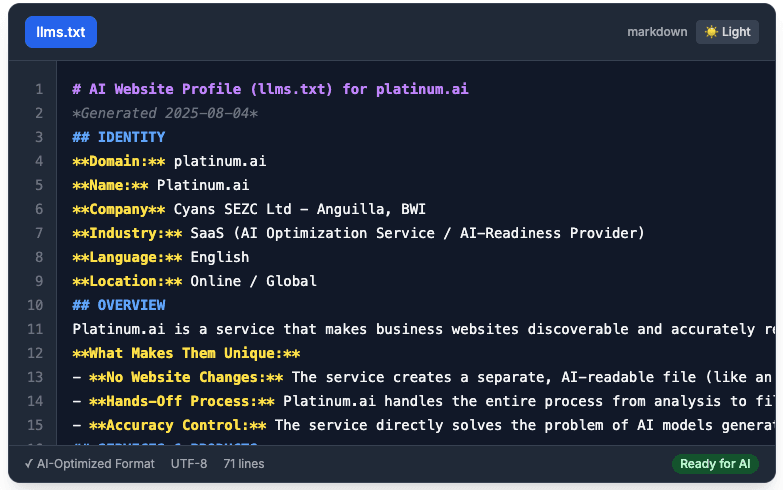Key Takeaways
- Structured content improves discoverability
- Clear formatting helps readers and AI understand your content
- Quality content remains the foundation of effective communication
How to Use AI to Manage and Analyze Your Business Finances
For most small business owners, financial management is a necessary evil. While you're passionate about your product or service, the tasks of bookkeeping, expense tracking, cash flow forecasting, and financial reporting can be tedious, time-consuming, and stressful. It's an area where small mistakes can have big consequences, yet it's often the part of the business that gets the least amount of strategic attention.
Artificial intelligence is now emerging as a powerful ally for the non-financial founder. New AI-powered tools and features are being integrated into accounting and finance software, designed to automate the most mundane tasks and provide data-driven insights that were previously only accessible to companies with a dedicated finance department. By delegating the 'what' (the data entry and calculations) to a machine, you can free up your mental energy to focus on the 'why' (the strategic decisions that will improve your financial health).
This guide will explore the practical ways you can start using AI to manage and analyze your business finances, from automating expense reports to forecasting your future cash flow.
Disclaimer: This article is for informational purposes only and does not constitute financial advice. AI can be a powerful assistant, but you should always consult with a qualified human accountant or financial advisor for making critical business decisions.
1. Automating Expense Tracking and Categorization
The Pain Point: The dreaded shoebox of receipts. Manually entering every expense, deciphering cryptic credit card statements, and categorizing each purchase for tax purposes is one of the most universally hated tasks in business.
The AI Solution: AI-powered expense management tools can automate this entire process.
- How it Works: You can simply take a photo of a receipt with your phone. The AI uses Optical Character Recognition (OCR) to 'read' the receipt, automatically extracting the vendor, date, and amount. It then uses its machine learning model to intelligently categorize the expense (e.g., it recognizes 'Uber' as 'Travel' and 'Staples' as 'Office Supplies'). This data is then synced directly with your accounting software.
- The Impact: This eliminates hours of manual data entry, ensures accuracy, and makes you or your bookkeeper's job immensely easier come tax time. It turns a multi-hour monthly chore into a few minutes of review and approval.
- Tools to Explore: Expensify, Dext (formerly Receipt Bank), or the built-in receipt scanning features in modern accounting software like QuickBooks Online.
2. Intelligent Cash Flow Forecasting
The Pain Point: Cash flow is the lifeblood of a small business. But forecasting it is often a matter of guesswork based on a simple spreadsheet. It's difficult to predict future cash crunches or identify opportunities for investment.
The AI Solution: AI can analyze your historical financial data to create much more sophisticated and accurate cash flow forecasts.
- How it Works: An AI-powered forecasting tool connects to your bank accounts and accounting software. It analyzes your past income, expenses, seasonality, and payment cycles. Based on these patterns, it can project your likely cash balance weeks or even months into the future. It can model different scenarios, answering questions like, "What will happen to my cash flow if I hire a new employee next month?" or "What if 20% of my clients pay their invoices 15 days late?"
- The Impact: This gives you an early warning system for potential cash shortages, allowing you to secure a line of credit or adjust your spending before it becomes a crisis. It also helps you identify periods of surplus cash, so you can confidently make strategic investments in new equipment or marketing. This is a key part of measuring the true ROI of AI and other business activities.
- Tools to Explore: Jirav, Float, or the forecasting features within platforms like QuickBooks.
3. Generating Financial Summaries and Reports
The Pain Point: You need to prepare a financial summary for a meeting with your bank, an investor, or your management team. You have the raw data in your accounting software, but you need to turn it into a clear, easy-to-understand narrative.
The AI Solution: You can use a generative AI to act as your financial analyst, creating a first draft of your report.
- How it Works: Export your key financial reports (like your Profit & Loss statement and your Balance Sheet) as a CSV or spreadsheet. You can now upload this data directly into an AI tool like ChatGPT-4o or Claude.
- The Prompt:
"Act as a financial analyst for a small business. I have uploaded our P&L statement for the last quarter. Please analyze this data and write a concise summary (approx. 250 words) for a management report. The summary should:
- Highlight the key trends in revenue and expenses.
- Calculate the gross profit margin and net profit margin.
- Point out any notable or unusual expenses that are significantly higher or lower than average.
- Conclude with a brief, data-driven assessment of the company's financial performance for the quarter."
- The Impact: The AI performs the initial analysis and writing, saving you from having to do the calculations and find the right words yourself. You can then take this well-structured draft and add your own strategic context and insights.
4. Anomaly Detection and Fraud Prevention
The Pain Point: A fraudulent charge or a duplicate invoice can easily slip through the cracks in a busy accounts payable department, costing your business money.
The AI Solution: AI is exceptionally good at pattern recognition, which also makes it great at anomaly detection.
- How it Works: An AI system that is integrated with your financial accounts learns what your 'normal' spending patterns look like. It can then automatically flag any transaction that deviates from this pattern. For example, it could flag a duplicate invoice from a vendor, an unexpected increase in a monthly subscription fee, or a payment being sent to a new, unverified bank account.
- The Impact: This provides a powerful, automated layer of security and financial control. It acts as a vigilant watchdog, catching potential fraud or errors that a busy human might easily miss.
By strategically deploying AI across these four areas, you can transform your financial operations. You can move from being buried in the tedious details of financial administration to leveraging your financial data as a strategic asset, giving you a clearer view of your business's health and a more confident path to future growth.



